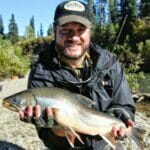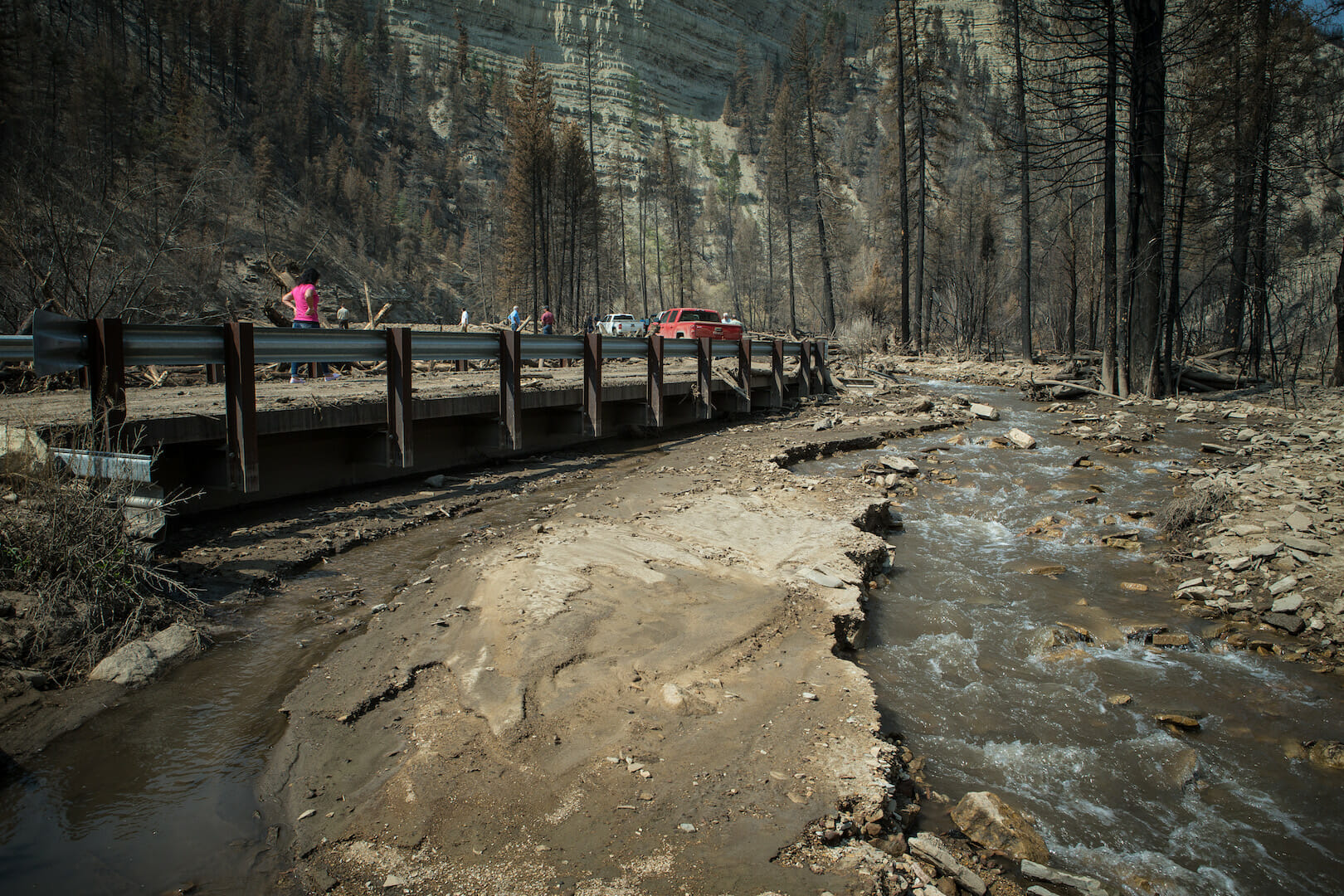The Dollar Ridge Fire in Utah raged over Strawberry Creek, a deisgnated Blue Ribbon Fishery. It will take time for the fish to return, but it will happen. Trout Unlimited will help the state with restoration efforts at the chapter, council and national level. Pho
to courtesy of the Duchesne County Sheriff’s Office.
By Paul Burnett
People tend to be creatures of habit. We like things to stay the same. Anglers are no different — we fish the same pools and reaches and maybe even fool the same fish more than once.
It’s tough, especially when a stretch of water that we fish frequently or that we have fished for many years undergoes a dramatic change. It seems to be happening more and more frequently. A wildfire rushes through one of our favorite streams resulting in the loss of another important trout fishery.
But things have been changing slowly for decades right in front of our eyes. Slow, incremental, hard-to-detect changes are pushing wildfire and its effects on the landscape, our fisheries and our communities into unknown territory across the West. Wildfire experts agree fires are getting progressively hotter and larger.
There are a number of thoughts being thrown around offering ideas about what to do in response to these fires. It’s helpful to look at fires through the lens of natural fire regimes, understand the direct and indirect impacts people have had on the way fires have been managed in the past, and what that means for the future, particularly with respect to coldwater fisheries.
In my state of Utah, several “Blue Ribbon Fisheries” have been devastated by fires including Huntington Creek (2013 Seely Fire), Clear Creek, and recently the Dollar Ridge fire, which ravaged the Strawberry River.
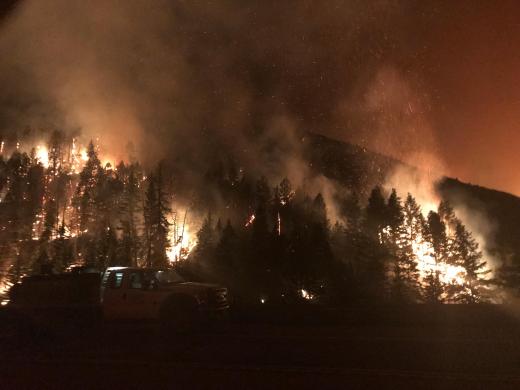
The Dollar Ridge Fire started July 1 and was human caused. It has burned 67,500 acres and remains only 90 percent contained more than a month later. Photo courtesy of InciWeb.
One reactive way to deal with wildfire threats to coldwater species is to move the fish. Biologists with the Utah Division of Wildlife Resources rescued a remnant population of Bonneville cutthroat trout from Ash Creek in response to the West Valley Fire earlier this summer. Indeed this is a commendable response from our state wildlife agencies to save these unique fish, but it begs questions like, do we have a place to move fish populations in an emergency? Can we really keep up with fires by saving populations? What is the role of fires within our watersheds and how are they affecting our fisheries? Are we prepared for the potential changes coming to our fisheries?
None of us were around in the West prior to the 1800s and that makes it difficult to know, with certainty, what wildfire was like prior to the western expansion of the United States. But fire ecologists have tried to gain a good picture by reconstructing past fire patterns. From 200 to 1,500 years ago, fire distributions were typically correlated with temperature and drought, much like today. But individual fires were generally smaller, less intense, and much more frequent. In fact most of the old-growth trees were able to survive the low-medium intensity burns, which helped to maintain forest integrity. So fires historically acted in the classic mosaic pattern, which resulted in a landscape with broadly variable timber stands and watershed conditions. Massive stand-replacing fires did happen though, and we shouldn’t dismiss the idea that large fires occur naturally.
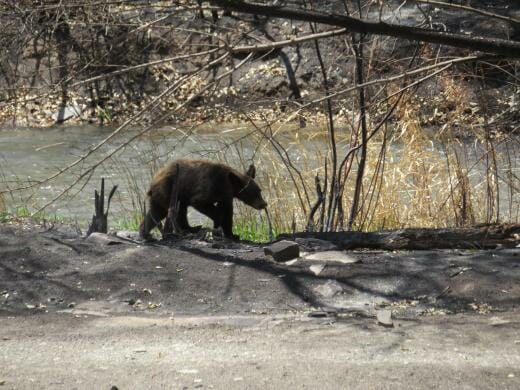
Fish are not the only wildlife impacted by wildfire. A black bear wanders along the Strawberry River in Utah after the Dollar Ridge Fire swept across the area. Photo courtesy of InciWeb.
Did fires kill fish historically? It is a safe bet they did. A common pattern is fires have the most potential impact on small- to medium-sized streams throughout the West. In these small (typically headwater) streams, it is not uncommon to lose an entire fishery due to fire, typically because a large proportion of the watershed burns. Losing a fishery to a fire is terrible, not only for those of us who enjoy fishing at a certain place, but also for the ecological and historical values represented by each fish population affected.
How did the fish deal with this historically? Generally speaking, fish took advantage of the broad geographic distribution of stream networks and moved. We know from research of western cutthroat trout subspecies that they generally moved long distances over their lifetimes. When streamflows dropped or temperatures rose, fish would often move to try to find suitable temperatures. If they couldn’t, they would die. It is possible individual populations were wiped out by fires, but the fish were able to move back into burned habitats from downstream areas once the watersheds stabilized.
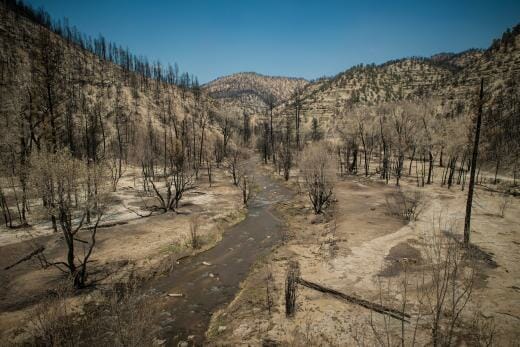
Erosion control is an issue after fire removes vegetation. Courtesy Duchesne County Sheriff’s Office.
How are fires acting now?
The fires we see on the landscape now are massive with individual fires typically burning 100,000 to 200,000 acres. These fires are the result of a complex recipe of four things:
-
We have spent decades aggressively suppressing wildfires everywhere as soon as they start. Although it’s heroic to fight wildland fires and we wouldn’t expect any less when faced with the potential loss of human life or property, this has resulted in a long-term slow accumulation of shrubs, trees and deadfall debris across millions of acres of federal, state and private land. Because of long-term suppression, millions of acres are loaded with fuel.
-
Long-term animal management throughout many forests and rangeland have set up conditions, favoring the establishment of woody shrubs and high densities of young coniferous trees, which are generally avoided by grazing and browsing animals. Persistent grazing and browsing pressure has also opened the door to invasive annual grasses such as cheatgrass, which have altered the fire regime in more arid landscapes, and created combustible understory conditions in coniferous forests..
-
Over the past two decades as climate change has progressed, the western United States has been subjected to unprecedented periods of extended drought. Year after year of drought has either killed trees or compromised them making them vulnerable to the massive beetle kills across many of the forests in the West further contributing to massive fuel loads.
-
Climate change is pushing the fire seasons longer by melting snow earlier and extending dry heat later into the fall. Heat is a primary contributing factor to the severity of wildfires. Some estimates suggest the fire season is 75 days longer than in the past.
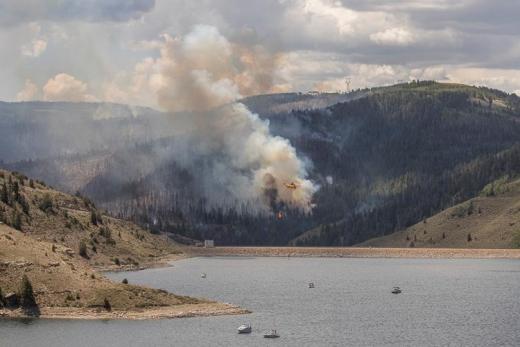
The Dollar Ridge fire burning just above the Strawberry River where it starts at Solider Creek Dam. Photo courtesy of InciWeb.
This recipe is creating conditions where fires have the potential to be explosive. We can view fire effects on fish in two timeframes—short-term and long-term. In the short term, the fires themselves can heat the water in the streams to lethal temperatures. It’s possible for trout to survive elevated temperatures if they can find thermal refuge areas such as springs and tributary inputs.
Today’s fires are also instigating major long-term changes to the watersheds where they burn because larger patches are burning at high intensities. Because of the massive fuel loads currently on the landscape and unprecedented periods of drought, recent fires burn extremely hot and with many high-severity areas within a fire. Added to the heat, their massive burn patterns are creating large areas where a fire has essentially baked the soil and created a crust that acts like an impervious surface (like a parking lot). Inevitably, after the fire season, a burn scar is hit with a heavy rain event.
The changes in the soil conditions results in what hydrologists refer to as efficient runoff. Instead of water percolating into subsurface areas of the soil, most of the water directly runs off and flows into the streams. The excessive runoff has a lot of energy as it flows downstream, and it causes massive erosion events and carries huge volumes of sediment and ash into the stream channels. These ash-ladened flood events sometimes last for years and are often sufficient to wipe out any remaining fish. Ecologically, these events reset the entire stream system, the forest is essentially burned and then the entire stream network is changed.
There is a silver lining. Riparian areas are incredibly resilient. They quickly recover on their own via natural regeneration post-fire. Although riparian areas look rough during the first several years after a fire, closer inspection shows extensive recovery from the still-living roots. When viewed in the long term (10 to 20 years post-fire), it is clear that fires can deliver benefits to fisheries by introducing large numbers of logs and tree roots, as well as adding in-stream gravel contributing to habitat diversity.
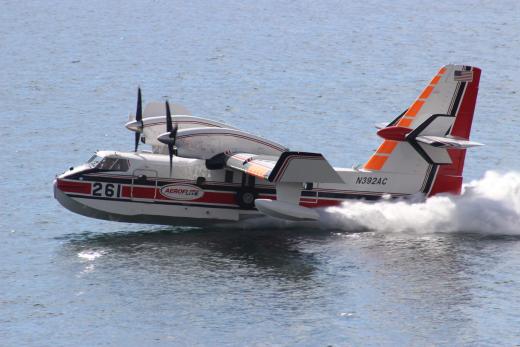
A tanker takes on water at Strawberry Reservoir to dump on the Dollar Ridge Fire. Photo courtesy of InciWeb.
The Triple Whammy – Intense fires, exotic species and habitat fragmentation
It is important not to forget the other compounding issues that worsen fire effects on fish. Many native cutthroat trout populations in the West have been eliminated from their historical core areas — the mainstem rivers where they used to roam. They have been pushed into small headwater streams by exotic species such as brook trout and brown trout, and their habitat has been highly fragmented by road crossings, dams and water diversions. Most cutthroat trout populations are now isolated, with no connection to other cutthroat trout populations within a river system. When a fishery is lost due to fire, the natural way of native fish repopulating the stream is no longer possible. The larger fires are also having impacts on larger watersheds. The historical processes have been thrown out of balance. Nowadays, it is not uncommon for a fire to wipe a cutthroat trout population off the map, and render a stream fishless. In other cases it’s the final event that pushes native trout out after exotic fish had already expanded and displaced most native fish in a stream.
Getting ahead of catastrophic fires
The current fire situation is incredibly complex and the simple solutions are inadequate to solve the complex challenges. It is essential to invest in strategic proactive actions. Fire ecologists recognize the current reactive fire suppression by triage is hemorrhaging money and preventing public land and fire managers from taking proactive actions. The challenge is how to effectively change the fuel loads across hundreds of millions of acres of forests and rangelands. A diverse range of “active management” tools, such as prescribed fire, judicious hands-off approaches to some wildfires, and even responsible forest thinning in high-risk areas are important tools to use. But we’ll need to prioritize places where specific actions are the right approach.
Active management is a tangible response, but great care is needed to avoid incurring massive public expenses and other major collateral damage to coldwater fisheries. For example, timber harvest and thinning requires the construction of extensive road networks to get the wood out. Fisheries biologists in the 1970s and 80s identified extensive sedimentation problems throughout the West caused by the thousands of miles of road networks constructed to support past logging efforts. Road networks cross streams, and each road culvert on the landscape represents a potential location that blocks fish from moving to thermal refuge areas or spawning habitats.
We also need understand the consequences of our sprawling development patterns in the forested West. We continue to punch developments into wildlands at a rate of 4,000 acres per day. The more people build next to wildlands, the greater the chance fires will have catastrophic human impacts.
Active management alone has not been able to keep up with the area of land burned, which leaves us in a tough cycle—large hot fires are the new normal for the foreseeable future and they are likely to intensify. Climate change is complicating the challenge by acting as a ratcheting force on fire behavior. It means our fisheries, particularly in forested landscapes, are at risk of being wiped off the map by a fire if we don’t take proactive steps to build their resistance to these new fires.
Rebuilding robust trout populations
Trout Unlimited is taking steps to prevent irreversible losses of our fisheries to fire. For decades, we have worked closely with partnering agencies and other non-governmental organizations to apply the “three-Rs” of conservation to cutthroat trout. These three Rs of conservation are a comprehensive approach to ensuring native fish can be sustained in our streams into the future.
The three-Rs of conservation focus on three principles. If a subspecies of cutthroat trout is managed to meet all of these principles, they are more likely to persist in the face of climate change and catastrophic wildfires.
-
Resilience: Having sufficiently large populations and intact habitats to facilitate recovery from rapid environmental change like a fire. Building the resilience of our coldwater fisheries is at the core of what we do as an organization. We are working throughout the West to remove barriers to fish migration, restore flows and make sure trout have access to all of the habitats needed throughout their life cycle and in emergencies such as a fire. Connected habitat allows fish from different parts of watersheds to naturally move back into areas that have been wiped out by fire.
-
Redundancy: Saving enough different populations so that some can be lost to events like fires without jeopardizing the species. TU has been involved in a wide range of population restoration projects across the western United States. It is an unfortunate reality, but many brown trout, brook trout and rainbow trout populations (or a mixture) have pushed out native trout. Although most of the projects are led by the states, we have supported many cutthroat population restoration projects in which the non-native trout have been removed to make room for native trout. This hasn’t been done just for the value of having another cutthroat trout population. It’s being done with the intent of increasing the redundancy of cutthroat trout populations, so when the fires do come and wipe out a watershed enough cutthroat trout of similar strains occur in other geographic areas.
-
Representation: Ensuring that native fish on the landscape have genetic diversity, variable life cycles and geographic diversity so a species can adapt to changing conditions, such as climate change.
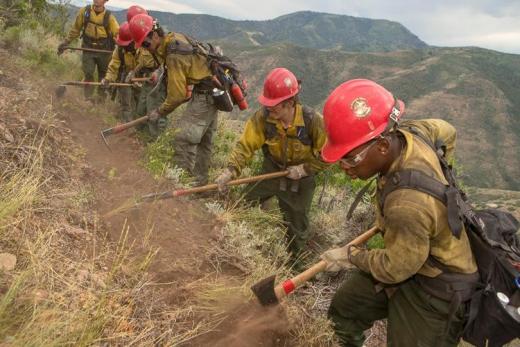
Thanks to all the firefighters working on the Dollar Ridge blaze and others across the country. Trout Unlimited appreciates your hard work. Photo courtesy of InciWeb.
Successfully conserving coldwater fish in the threat of massive wildfires requires a persistent collaborative effort among broad partnerships. Credible partnerships are formed when all partners can bring unique perspectives and resources to the table and develop constructive solutions. Throughout the Intermountain West, interactive groups work together on a wide range of challenges that cutthroat trout subspecies face.
With respect to fire, TU members and chapters can play several important roles.
-
Help raise funding for fish passage and habitat restoration projects to build the resilience of existing fisheries.
-
Participate in revegetation efforts after fires and work with agencies in a collaborative problem-solving approach.
-
Support and participate in cutthroat population restoration projects. It can be disheartening to see a brown trout fishery changed to cutthroat trout. But when the broader challenges that the native trout face are factored into these decisions, it’s important to take on these projects with a unified effort.
-
Continue to understand the current research investigating wildfire effects on the landscape and our fisheries. Use that information to inform local, state, and federal decision makers about smart development patterns to reduce the potential of human casualties from wildfire.
-
Be carbon smart. Understand how we all are changing the carbon cycle, and how carbon is driving temperatures, drought patterns, and climate. TU is engaged on important climate change issues, because a warming climate puts great pressure on our beloved coldwater fisheries. Click on this link to visit TU’s Climate Change page.
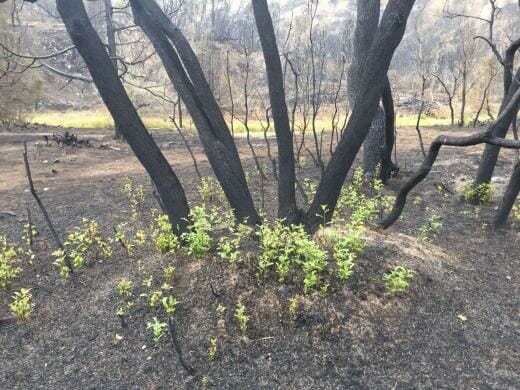
It doesn’t take long for some plants to start anew after wildfire. Often, the first green to show up is not native to the landscape posing other issues for wildlife and future wildfire fighting efforts. Photo courtesy of InciWeb.
Wildfires are often reported with negative undertones — catastrophic, destructive, deadly. Although these adjectives may be accurate, wildfire is important in the western landscape. We can’t accurately predict where on the landscape fires are going to occur, but we can take strategic actions to ensure that when a fire does occur, our unique fisheries will persist. It’s incredibly important to get beyond the triage culture of responding to and defeating fires, and be more proactive and prepared for fires. Thinking about losing our favorite water may make us cringe, or worse, but understanding that fire is a natural process and putting as many tools on the ground to improve the strength of native trout populations is the best chance we have of ensuring that our kids and grandkids will continue to receive the gifts of our natural streams and rivers.
Paul Burnett is the Utah Water and Habitat Program Lead for Trout Unlimited. He is based out of Ogden, Utah.


